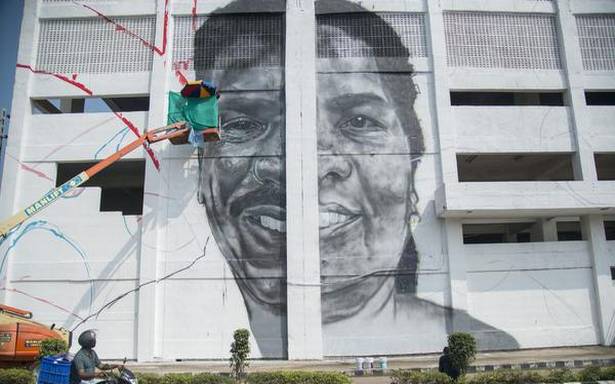The main facade of Indira Nagar MRTS is now a canvas for a panoramic mural that raises awareness on the stigma associated with HIV/AIDS
A black-and-white photographic portrait featuring halved, smiling faces of a man and a woman stands tall against a radiant blue sky dotted with clouds. The half-faces seem to merge into each other on a single wall. Their carefree smiles that somehow seem familiar are spread across Indira Nagar MRTS’ main facade along the Rajiv Gandhi IT Expressway. This portrait by Chennai-based graffiti writer and street artist A-Kill is one of 10 that, within the next 10 to 12 days, will be spread across the 280-metre-long facade as a panoramic mural. Often only identified by its peak hour traffic, the expressway will now carry art that urges to destigmatise and raise awareness about HIV/AIDS.
An initiative by St+art India Foundation and Tamil Nadu State Aids Control Society (TANSACS) along with Tidel Park and Southern Railway, the mural was initiated in an attempt to wake the city up to the discrimination faced by people with HIV. It also reflects the theme of this year’s World AIDS Day as declared by UNAIDS — Global Solidarity, Shared Responsibility.
To that end, portraits of people with HIV and otherwise are placed one after the other to drive home the point that there are no physical determinants to AIDS. Aptly titled ‘We Are’, the public art project is actualised by A-Kill and Delhi-based street artist Khatra, and assisted by Chennai-based artists Raghupathy and Jaya. Though the recent showers in the city disrupted their work briefly, the team, which has been working since December 23, is now back on the ground to complete the mural within a fortnight.
“I will be drawing 10 very familiar, faces. Among these will be faces of those with HIV as well. This is to show that at the end of the day we are all human. This is the core concept behind the work,” says A-Kill, of the project curated by Guilia Ambrogi, co-founder of St+art India Foundation.
Graffiti writer and street artist A-Kill at work | Photo Credit: special arrangement
The first portrait that features on the facade is that of a couple with HIV/AIDS. A-Kill, whose works derive from street photography, had shot them at Chengalpattu while researching for the project. Other faces are inspired by some of the earlier shots from his photo library. While some images will be photo manipulated to protect the subjects’ identities, others (with permission) will be portrayed as is.
A-Kill’s creative process spurts from something called a lazy grid or doodle grid, which are markings across the wall that help him ascertain the scale of the surface. On these seemingly incoherent markings, the image is superimposed. This time, however, to make the documentation process more interesting, a poem was scribbled on the wall as a lazy grid. Khatra, on the other hand, is working on a colourful backdrop on which A-Kill’s work will rest. He has already done the markings and will return to the city again to complete the mural. “There will be a red ribbon running throughout the entire portrait,” adds A-Kill. The project will be 65 feet by 903 feet in dimension.
Regarding the choice of the wall, A-Kill who was assigned to the project after the wall was chosen, says, “The Indira Nagar MRTS wall is the ideal one to paint on with very few obstructions. It is also a long stretch. The other [MRTS] surfaces were layered .”
Source: Read Full Article


